Llyn Bran Discontinuance (2023)
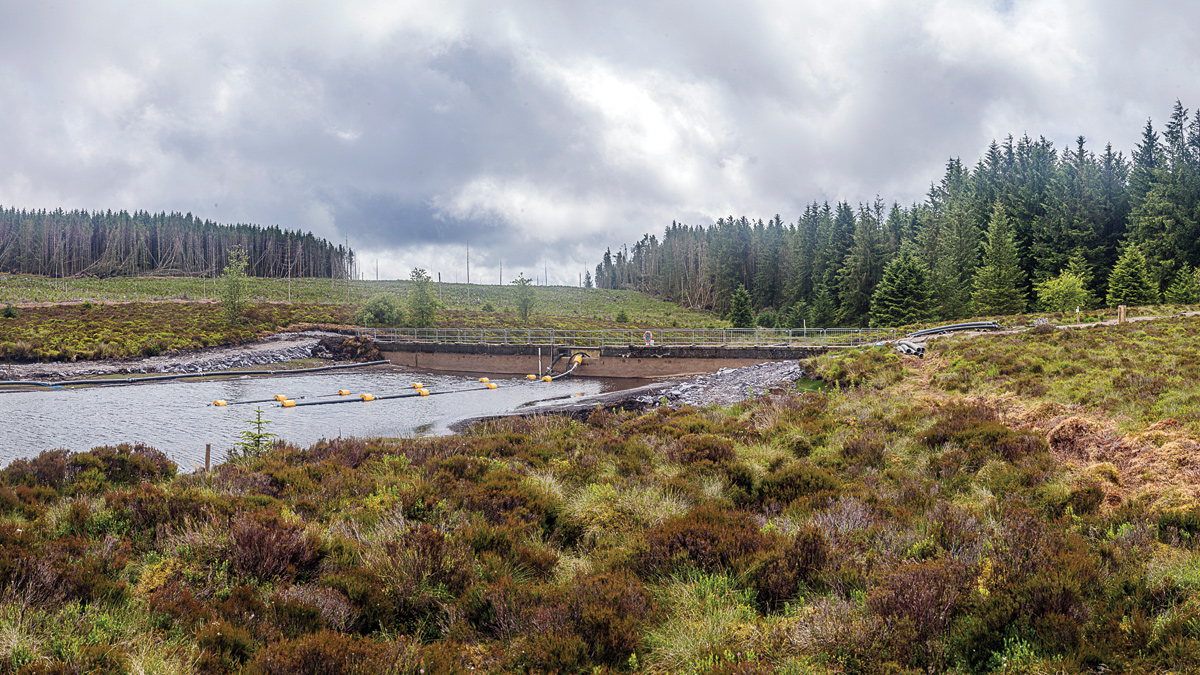
Siphons being used to lower the reservoir to its original level - Photo by Eye Imagery, courtesy of Welsh Water
Llyn Bran is located in Denbighshire, north-east Wales and was a natural lake that was raised in 1899 by a concrete dam. The reservoir was used to supply water to the North Wales Hospital in Denbigh. The hospital closed in 1995 and Llyn Bran has not been used for drinking water since. As part of a separate discontinuance scheme at Llyn Anafon, Llyn Bran was identified as a ‘compensatory site’ for the loss of habitat at Anafon. One element of turning Bran into a compensation site was the removal of the dam, as well as other ecological enhancements. Through careful restoration work, Llyn Bran will eventually become a Special Area of Conservation.
The reason for Llyn Bran discontinuance
Llyn Bran Reservoir is required as a ‘compensatory site’ for the loss of habitat area that will be caused by discontinuing the dam at Llyn Anafon Reservoir, as required by the Habitats Directive.
Llyn Anafon Reservoir was originally a natural lake which was raised by 1.4m in 1931 through the construction of an embankment dam. The use of this site for local water supply ended in 2002. A 2016 S10 inspection of Llyn Anafon resulted in a MITIOS (Measures in the Interests of Safety) to “develop a long-term solution to the poor and deteriorating condition of the dam”. In January 2019, it was agreed with relevant regulators that to provide a long-term solution, the reservoir would need to be decommissioned, with the dam structure removed and the lake lowered by 1.4m.
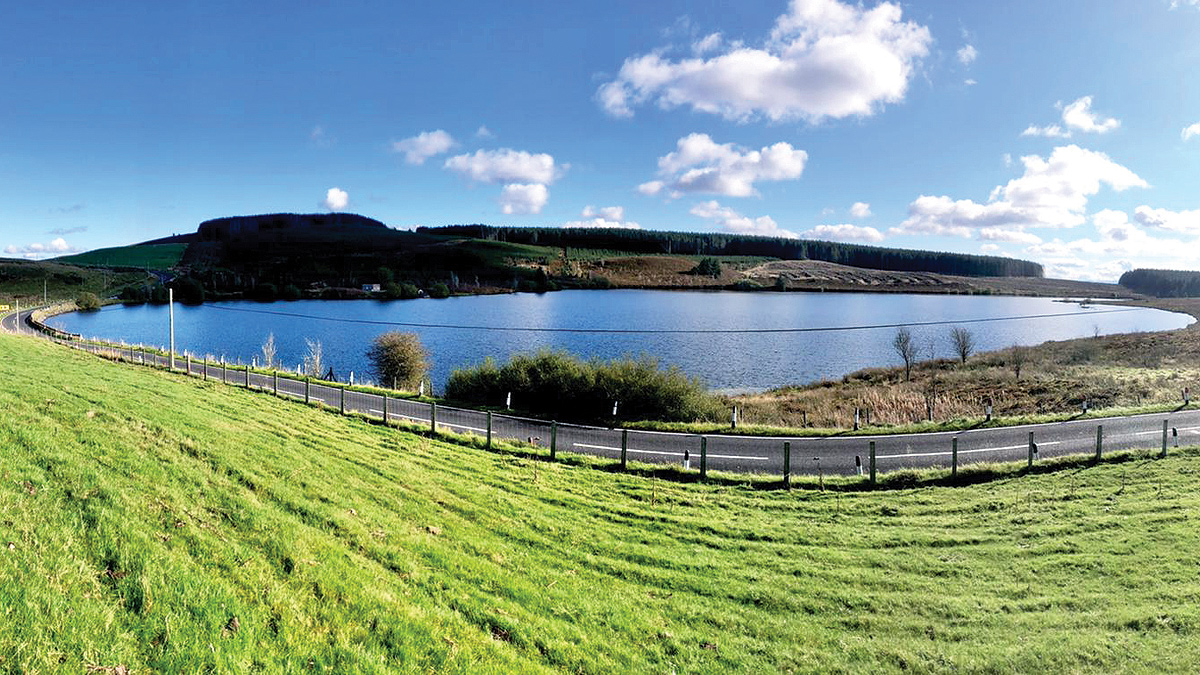
Llyn Bran before discontinuance – Courtesy of Welsh Water
Llyn Anafon is nationally and internationally protected for specific conservation features. This means prior to any project taking place, a full Habitats Regulation Assessment (HRA) had to be undertaken. The outcome of this assessment was that it was not possible to avoid adverse impacts to protected features and as such, the only route to proceed with the project was under the “Imperative Reasons of Overriding Public Interest (IROPI)” (Article 6.4 of the Habitats Directive) on the grounds of public safety. The Anafon Dam Discontinuance Scheme is the first IROPI case of its kind in the UK and has recently been approved by Welsh Government.
To satisfy the IROPI case, Welsh Water was required to secure ‘compensatory measures’ for the loss of habitat at Anafon. Using a set of criteria agreed with National Resources Wales (NRW), Llyn Bran was identified as the most suitable site to provide the necessary compensation. A key element of the work was to ‘restore and maintain hydrological functioning’ i.e., removal of the dam to create a natural lake and restore connectivity to the downstream watercourse.
Although the primary reason for discontinuing Llyn Bran was for compensation, it also had the added benefit of removing a dam which was no longer needed for operational purposes.
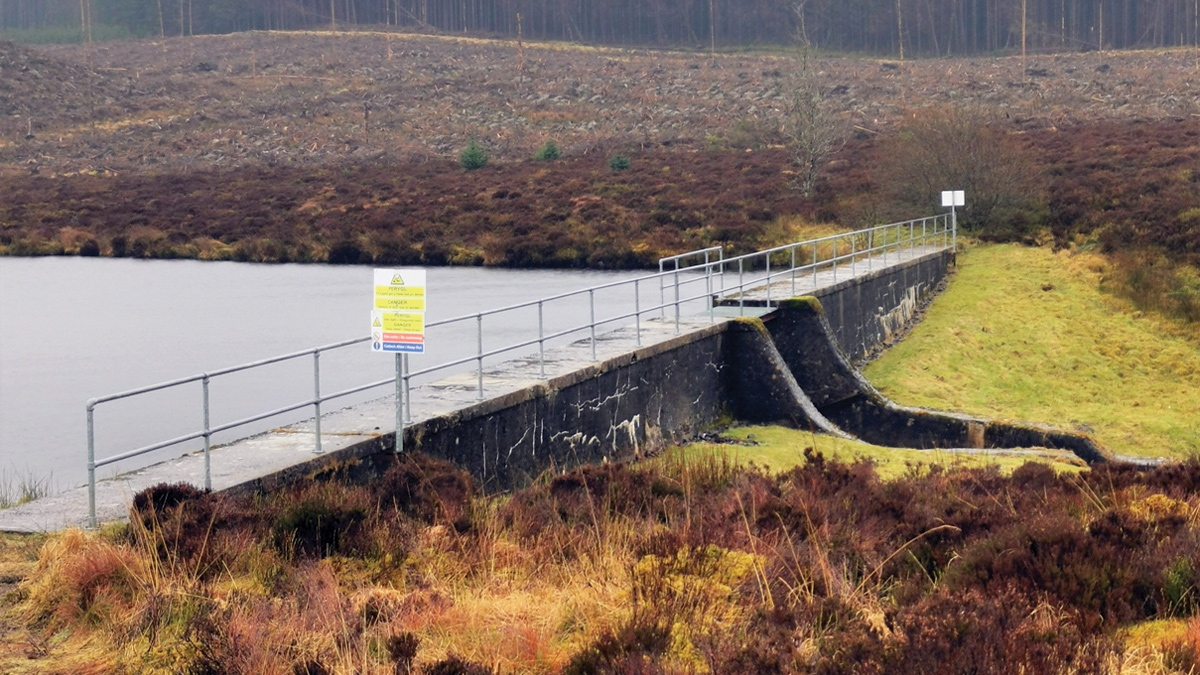
Llyn Bran dam before discontinuance – Courtesy of Welsh Water
Scope of works
- Create temporary construction access using bog mats.
- Draw down the reservoir by means of siphon pipes and pumps.
- Remove silt from the area immediately upstream of the dam.
- Demolish the entire dam and remove arisings for disposal off-site.
- Restore the watercourse channel downstream of the retained natural lake, incorporating silt management and retention measures.
- Create new water vole habitat along the shore areas of the retained natural lake using coir matting.
- Demolish outbuildings and associated structures with all building waste removed for disposal off-site.
- Remove exposed sections of pipework. Buried pipework to be sealed and filled by grouting.
- Install new roadside fencing along the north end of the reservoir.
- Install rip-rap protection around the upstream end of the B4501 culvert.
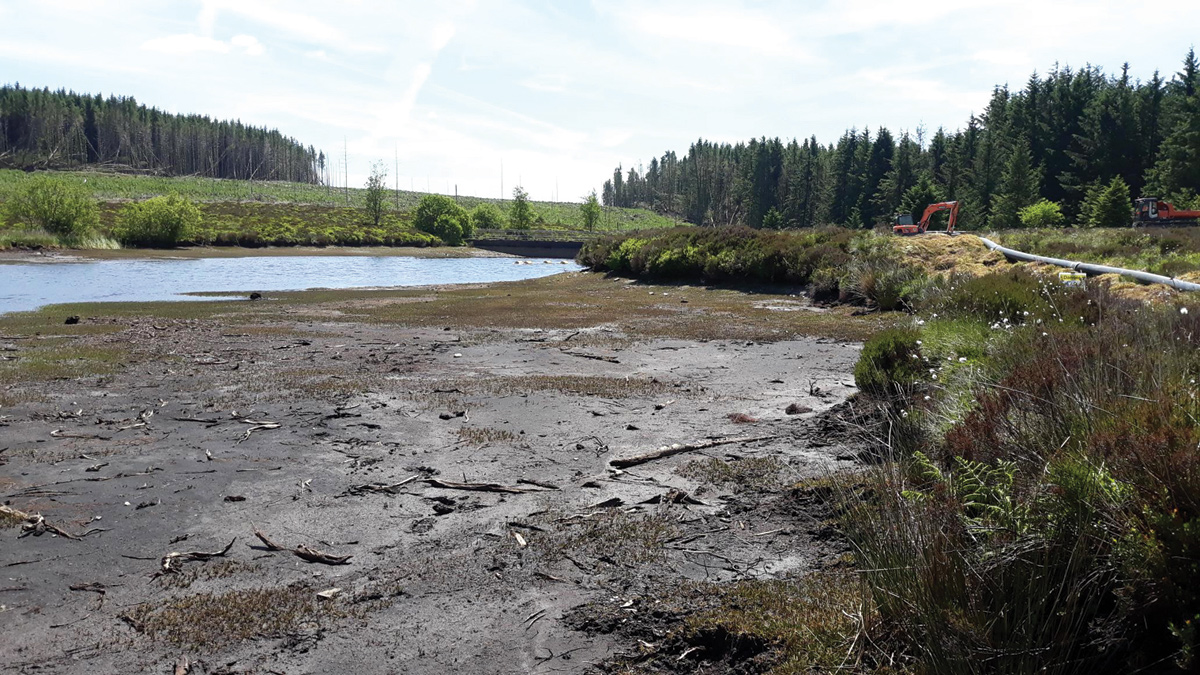
Ground conditions – Courtesy of Welsh Water
As with all discontinuance schemes the various surveys, permits, consents and negotiations in advance of the physical works were particularly complex, taking more than two years to complete. An overview of the consents and constraints required is below:
- Impoundment Licence and SSSI consent from Natural Resources Wales (NRW).
- Permitted Development Certificate from Denbighshire CC.
- Ordinary Watercourse Consent from Denbighshire CC.
- Protected species licence required for trapping and temporarily removing water voles (this was needed before permitted development could be granted).
- Annex 1 Habitats present around lake margins.
- Reservoir drawdown rate limited to 120 l/s.
- HRA level 1 & 2 required.
- Peat bog deposits along route of temporary access track.
- Bat surveys required prior to demolition of valve house & boat house.
Challenges & constraints
Site access
With no formal access track to the dam, and the surrounding land being designated as Annex 1 Habitat due to the presence of peat, access was one of the main challenges. With 140 peat depths probes taken along the route of the proposed access track, and working closely with NRW, a methodology was developed for installing over 280m of bogmats to the dam without the need to excavate and remove the top layer of peat. This minimised the potential damage to the peat and made site reinstatement far easier.
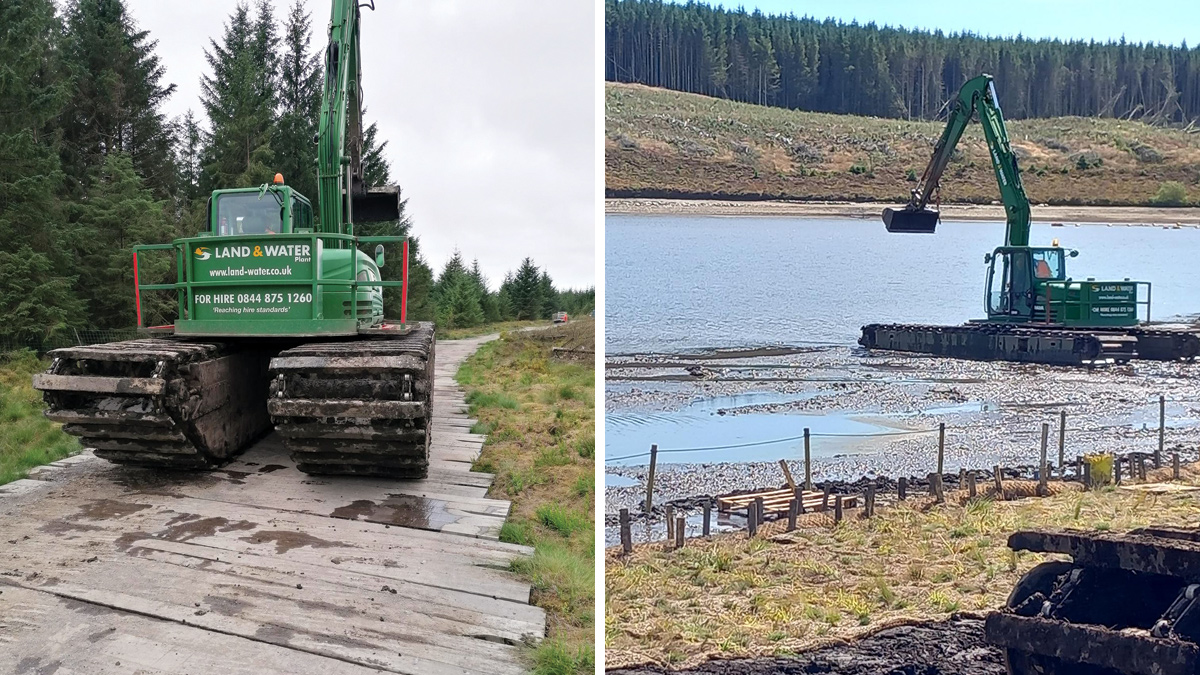
(left) Bog mat access track and (right) amphibious excavator used to load barge with coir matting – Courtesy of Welsh Water
Peat
The extent of peat encountered on site was far greater than expected once construction began. This resulted in an entire change in the contractors methodology for the coir matting. It was initially planned to use Bog Master excavator and tracked dumper to access the western shore of the reservoir, however it quickly became clear this was not practical. Thanks to the contractor being proactive, the methodology was quickly changed to using an amphibious excavator and barge, to transport the coir matting across the reservoir.
Water voles
Water voles were identified on site during the early site survey stages, meaning a licence was required to temporarily remove the voles during construction.
Six water voles were captured by specialists and were transferred to a facility in Kent, where they were looked after while the work took place. A condition of the licence was that there must be 5-days with no water voles captured before it could be concluded that all voles were removed from site. Rather unluckily, there were two occasions where a vole was captured at the end of the fifth day, meaning the process took far longer than expected and the licence had to be extended. The voles are due to return home to Llyn Bran this summer.
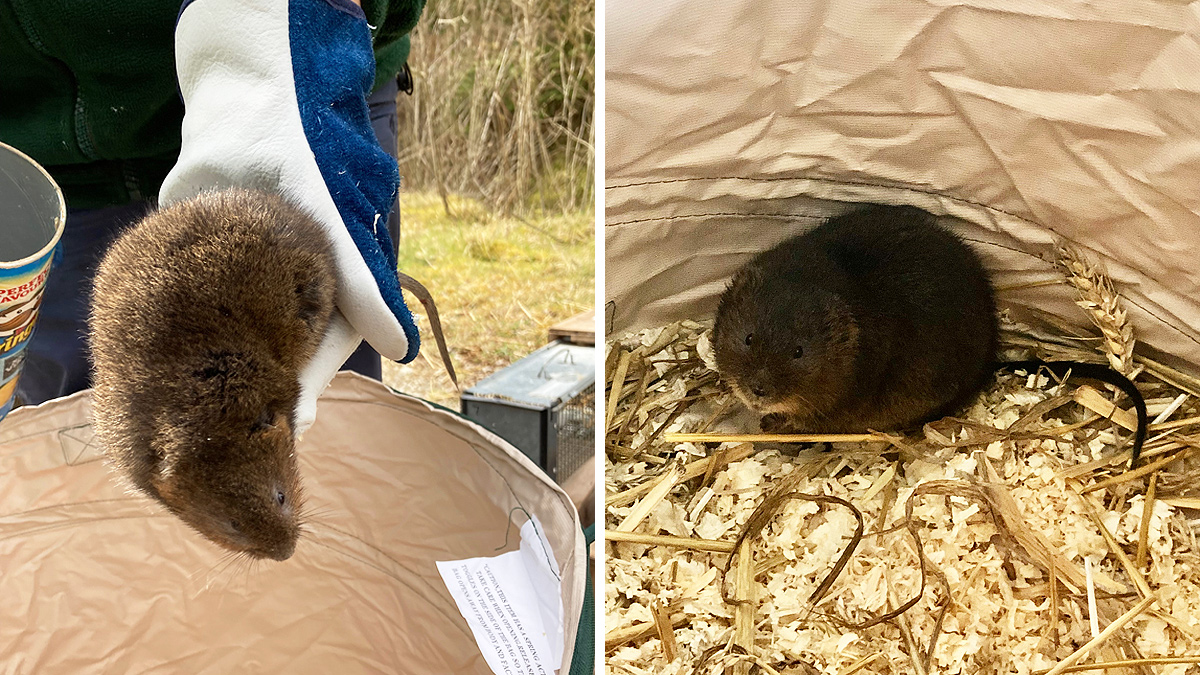
Water voles were captured and transferred to a facility in Kent for the duration of the works – Courtesy of Welsh Water
Compensation flow
A condition of the NRW impoundment licence was for a continuous compensation flow of at least 20 l/s for the duration of the works. This meant pumping to the watercourse, which had to be continually monitored. It was hoped to use a cloud-based telematics tool that makes it easy to monitor the pumps off-site but unfortunately, due to lack of signal, this did not work meaning William Hughes Civil Engineering needed to attend site over the weekends to check on the compensation flows. The summer of 2022 proved to be exceptionally dry, which crated a challenge in meeting compensation flows whist also not allowing the remaining lake to become too low.
Flood risk
The existing reservoir provided significant flood attenuation meaning the discontinuance increased the flood risk to a downstream highway culvert. Initially, there were concerns from the highways department that the culvert would need to be upsized, which would have added significant costs to the project. Following a detailed flood risk and stability assessment, Welsh Water were able to prove that the increased flood risk would not adversely affect the culvert and only minimal slope protection work around the culvert was required.
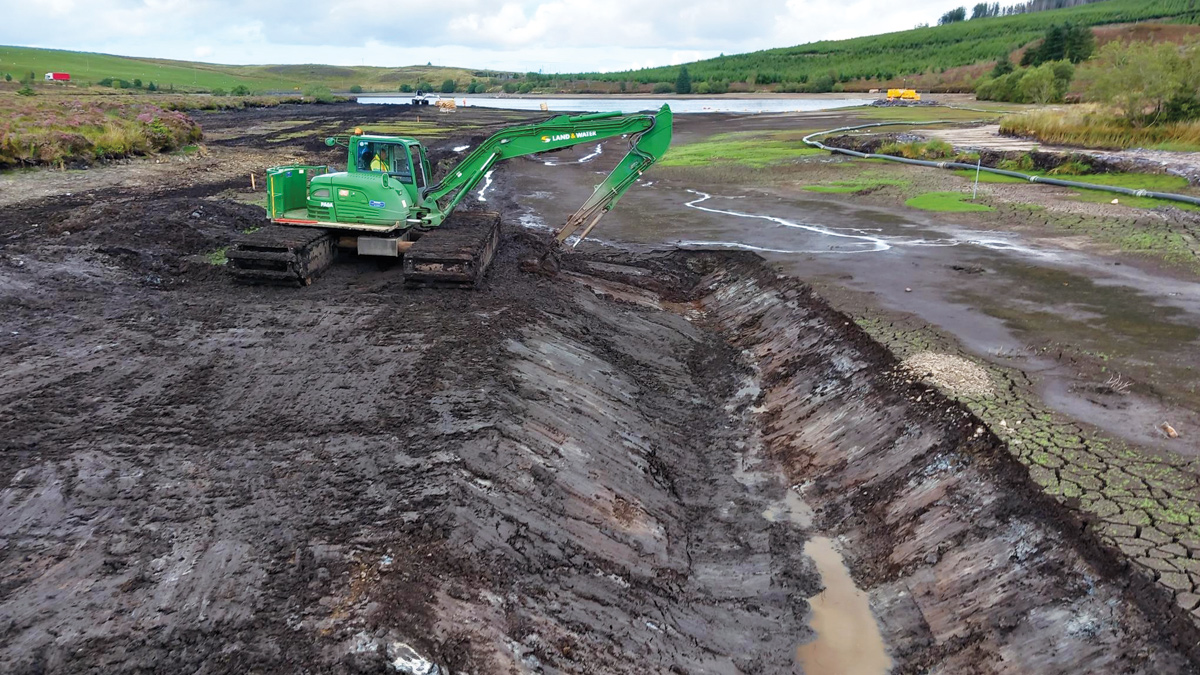
Amphibious excavator forming the new channel connecting to the downstream watercourse – Courtesy of Welsh Water
Llyn Bran Reservoir Discontinuance Project
- Construction timeline: 16 May 2022 – 4 November 2022
- Project cost: £1.7m
- Drivers: Dam safety | Habitats Directive | Reducing costs | Ecological compensation measures
Supply chain – key participants
- Principal Contractor: William Hughes Civil Engineering
- Design Partner: Stillwater Associates
- Environmental Consultants: Ricardo Energy & Environment
- Ecology/water vole licensing: Wildwood Ecology Ltd
- Silt management: Salix River and Wetland Services
- Amphibious excavator hire: Land and Water Plant
Opportunities & Savings
Forestry culvert
At the design stages there were concerns about the condition of a nearby downstream forestry culvert and its ability to accommodate the reservoir outflows during emptying. Expertise within Welsh Water was utilised by requesting a CCTV survey of the culvert via the wastewater team. The team provided a prompt and efficient service and enabled us to confirm the capacity and condition of the culvert.
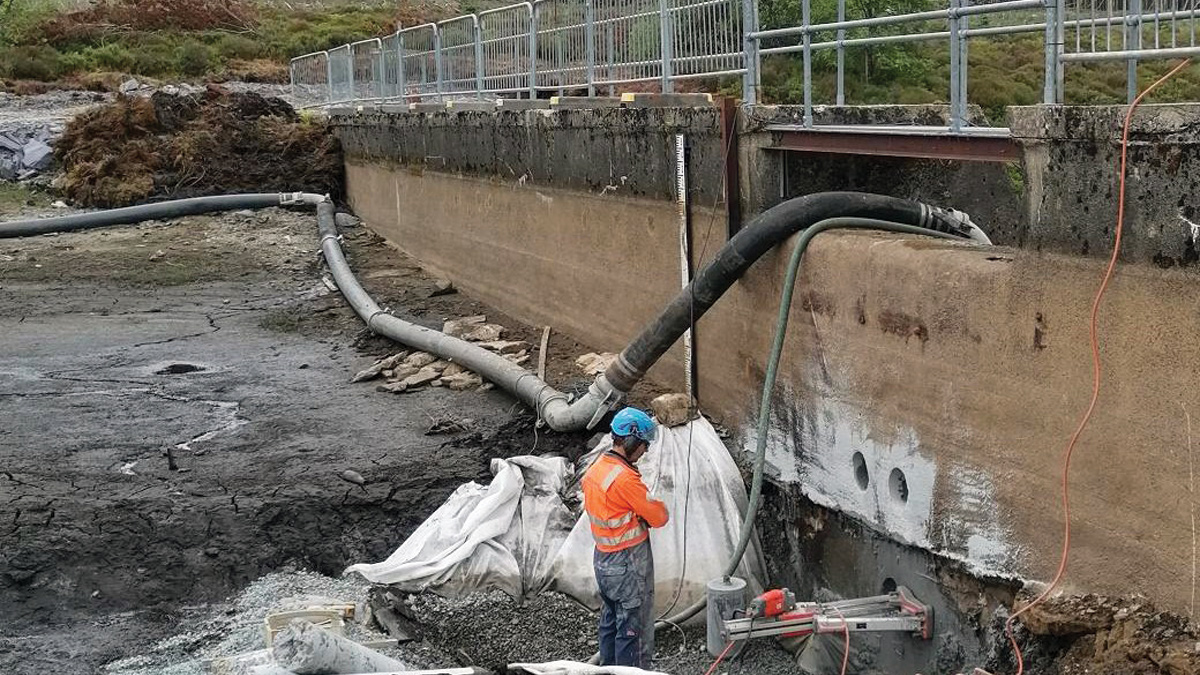
Cores being drilled through concrete dam to allow any extreme storm flows to pass through – Courtesy of Welsh Water
Dam safety mitigation
During detailed design, the Dam Safety Team suggested coring holes though the concrete dam once the reservoir was drawn down to the required level. This would mitigate the risk of the reservoir refilling during severe weather, before the dam was fully demolished. Fortunately, on this occasion the weather was favourable and the cores were not needed. This approach will be considered for any future concrete dam discontinuances.
Waste removal
It was agreed with NRW that the stone from the haul road and compound could be transferred to a nearby quarry, just down the road from site. This was done under a waste transfer notice, saving costs. The arisings from the dam were removed off site. The dam was demolished far easier and quicker than expected, making the removal of concrete straightforward.
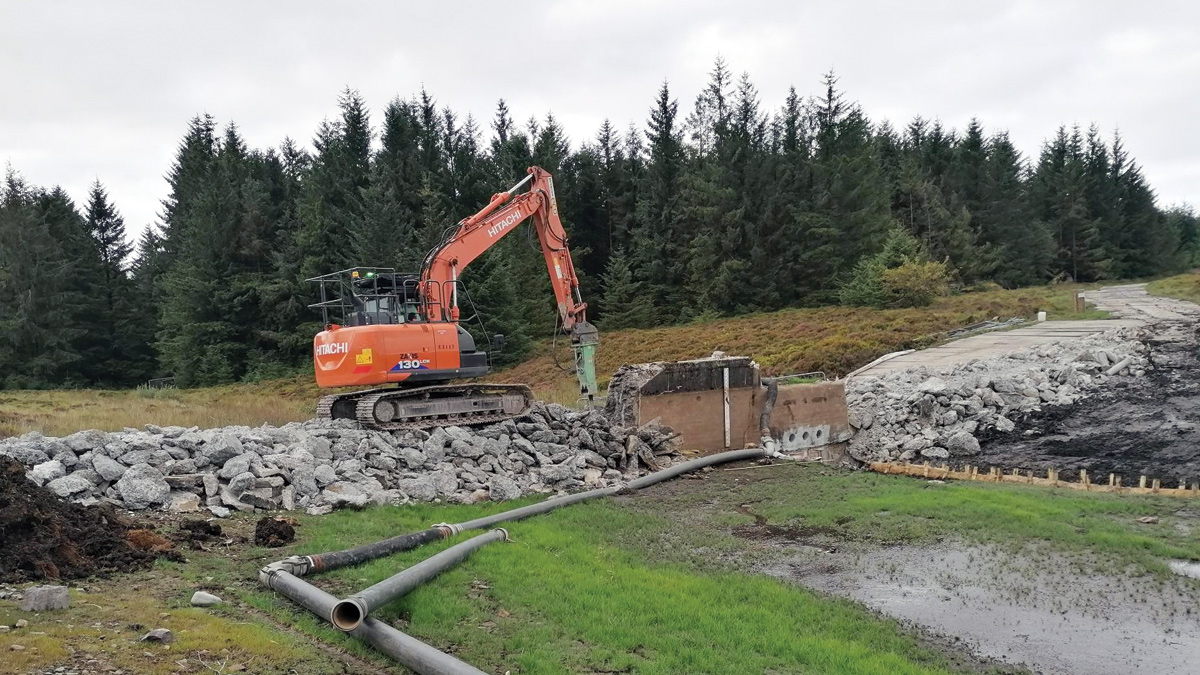
Dam demolition in progress – Courtesy of Welsh Water
Coir matting
Due to the silt being drier than anticipated, there was spare rolls of coir matting left over. Rather than this being wasted, it was moved to nearby Alwen WTW where it is being stored before being used for silt management on the upcoming Cilcain Discontinuance Scheme which is due to start this spring.
The future for Llyn Bran
The discontinuance will give significant biodiversity opportunities in relation to the marginal areas around the retained natural lake and with the restored connectivity to the watercourse. The retained lake will also be used as a receptor site for aquatic plants translocated from Llyn Anafon.
Long term ecological monitoring of the lake is required to ensure the compensatory criteria are met. This includes water quality and macrophyte monitoring as well as botanical surveys to check the natural regeneration of exposed shore habitats. A condition of the water vole licence is that activity is monitored until 2034. Through careful management and monitoring of the site, it is hoped that Llyn Bran will become recognised as a Special Area of Conservation.
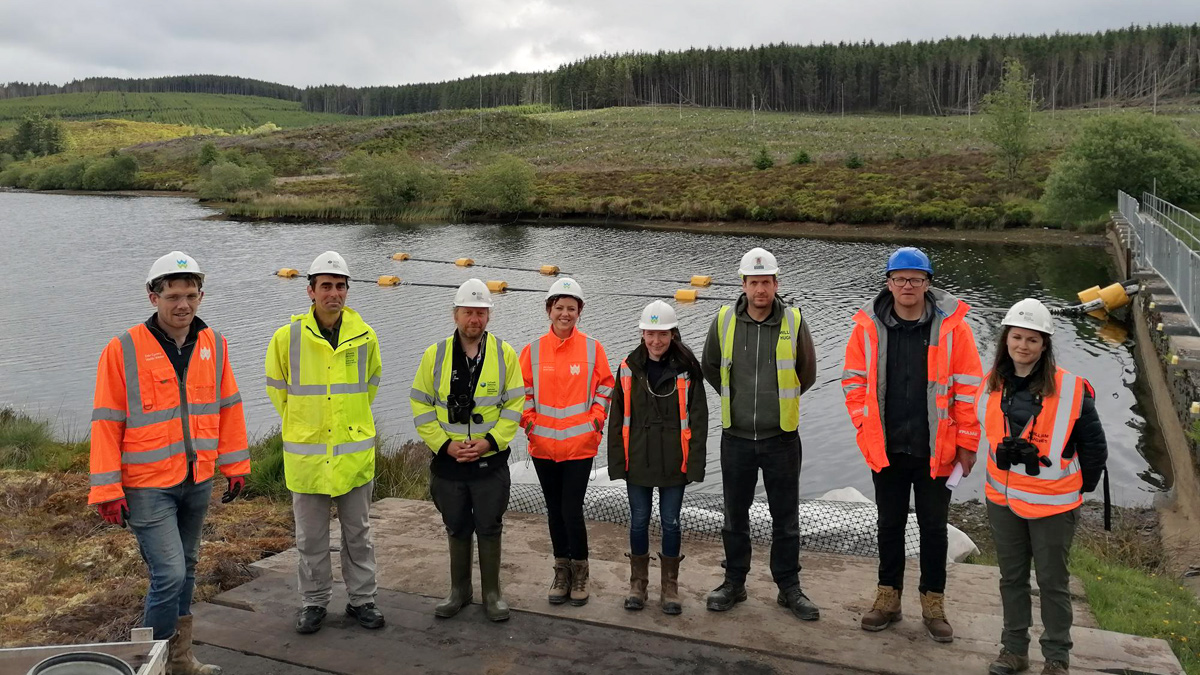
Collaborative site meeting with NRW, William Hughes Civil Engineering, EDT and Dam Safety - Courtesy of Welsh Water



